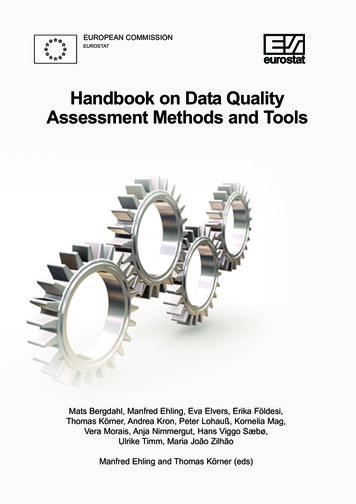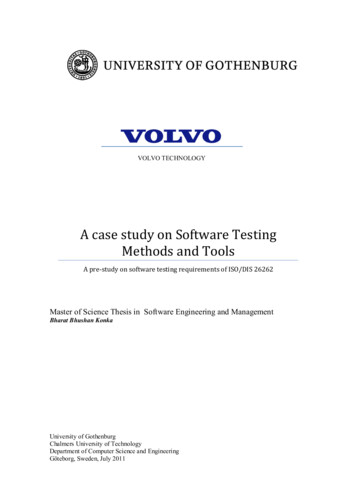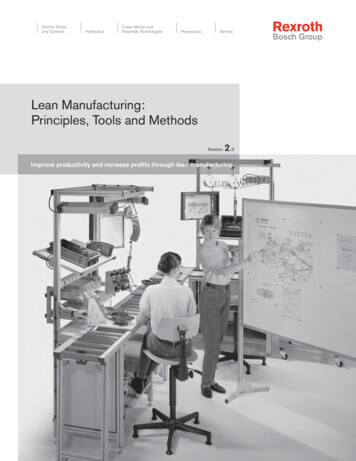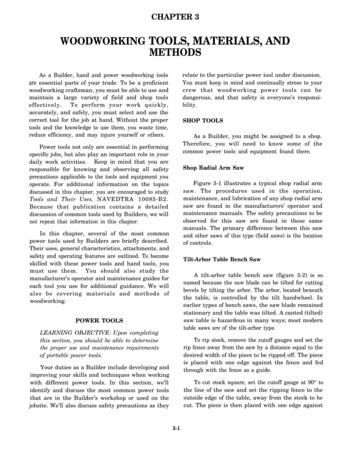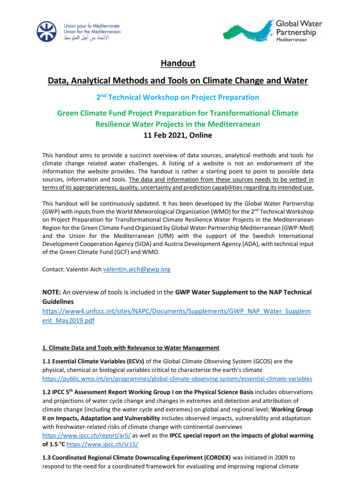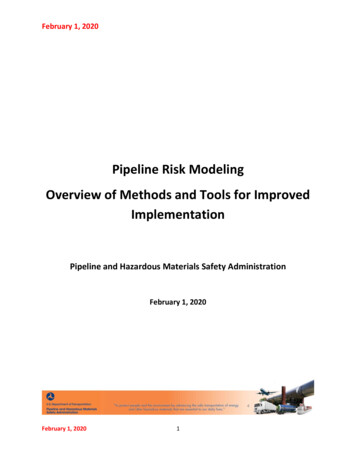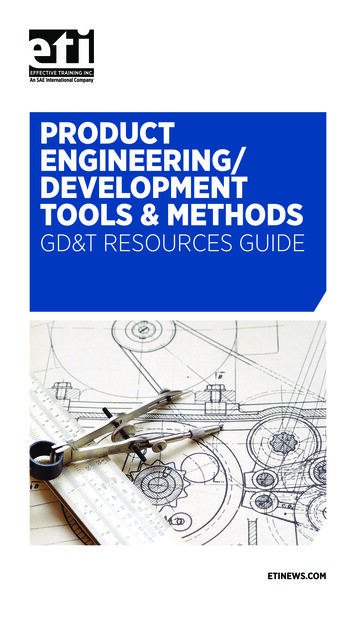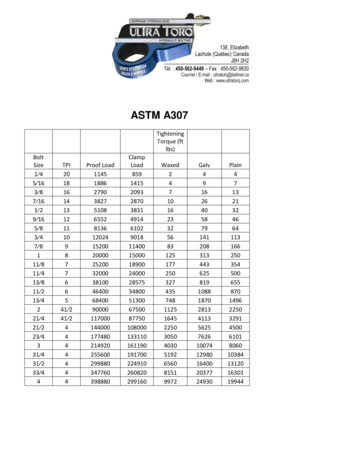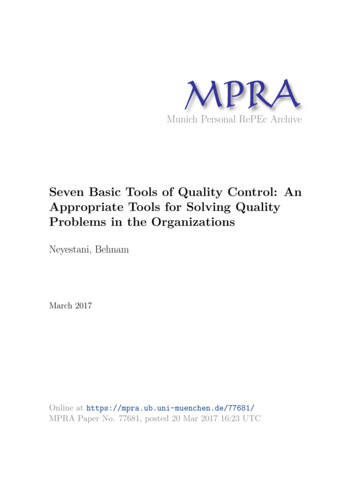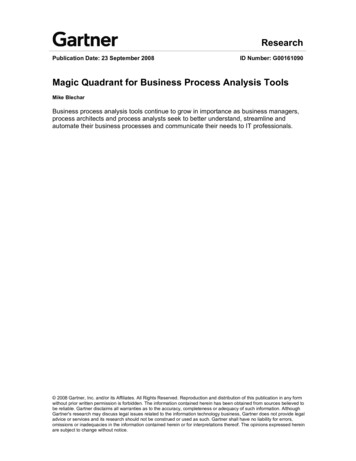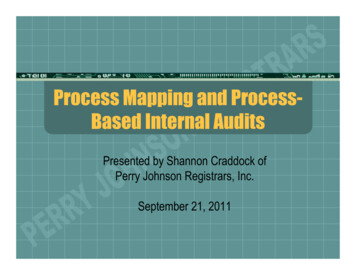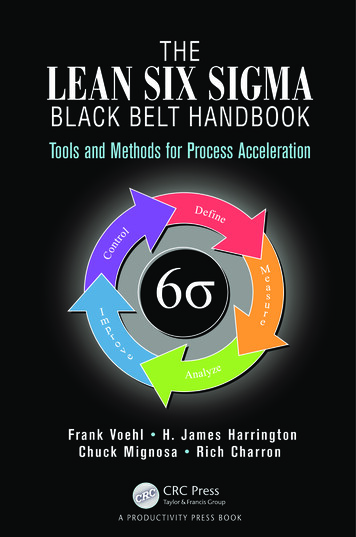
Transcription
THELEAN SIX SIGMABLACK BELT HANDBOOKTools and Methods for Process AccelerationFra n k Voehl H . Jame s Ha r ri n g t o nC h u ck M i gnosa R i ch Ch a r ro n
THELEAN SIX SIGMABLACK BELT HANDBOOKTools and Methods for Process Acceleration
THELEAN SIX SIGMABLACK BELT HANDBOOKTools and Methods for Process AccelerationFra nk Voeh l H . Jam es H arrin g t onChuck Mig n osa R i ch Ch arronBoca Raton London New YorkCRC Press is an imprint of theTaylor & Francis Group, an informa businessA PRODUCTIVITY PRESS BOOK
CRC PressTaylor & Francis Group6000 Broken Sound Parkway NW, Suite 300Boca Raton, FL 33487-2742 2014 by Taylor & Francis Group, LLCCRC Press is an imprint of Taylor & Francis Group, an Informa businessNo claim to original U.S. Government worksVersion Date: 20130426International Standard Book Number-13: 978-1-4665-5469-6 (eBook - PDF)This book contains information obtained from authentic and highly regarded sources. Reasonable effortshave been made to publish reliable data and information, but the author and publisher cannot assumeresponsibility for the validity of all materials or the consequences of their use. The authors and publishershave attempted to trace the copyright holders of all material reproduced in this publication and apologize tocopyright holders if permission to publish in this form has not been obtained. If any copyright material hasnot been acknowledged please write and let us know so we may rectify in any future reprint.Except as permitted under U.S. Copyright Law, no part of this book may be reprinted, reproduced, transmitted, or utilized in any form by any electronic, mechanical, or other means, now known or hereafter invented,including photocopying, microfilming, and recording, or in any information storage or retrieval system,without written permission from the publishers.For permission to photocopy or use material electronically from this work, please access www.copyright.com (http://www.copyright.com/) or contact the Copyright Clearance Center, Inc. (CCC), 222 RosewoodDrive, Danvers, MA 01923, 978-750-8400. CCC is a not-for-profit organization that provides licenses andregistration for a variety of users. For organizations that have been granted a photocopy license by the CCC,a separate system of payment has been arranged.Trademark Notice: Product or corporate names may be trademarks or registered trademarks, and are usedonly for identification and explanation without intent to infringe.Visit the Taylor & Francis Web site athttp://www.taylorandfrancis.comand the CRC Press Web site athttp://www.crcpress.com
This book is dedicated to the thousands of Lean Six Sigma Belts that JimHarrington and I have had the privilege of mentoring and certifyingover the past 10 years. And to the Four Horsemen of the QualityMovement—Deming, Juran, Crosby, and Feigenbaum. Thank you forteaching us how to teach, and for encouraging us to find a better way.Frank VoehlI dedicate this book to the person who created me and gave meher love—my mother, Carrie, and to the person who helped moldmy life and made me what I am—my wife, Marguerite.H. James HarringtonThis book is dedicated to two people who have hadthe most profound impacts on my life—my dad and my daughter. To my late dad, Edmund J. Charron, whoin my formative years provided a steady stream of learning exercisesthrough quotations, principles, and actions. Unbeknownst to meat the time, these gems of his essence would intermittently emergethroughout my life and guide me just when I needed them the most.To my precious daughter Hali, who as a child taught me that love isthe most powerful force in the universe. Like my father before me,may I provide to you through word and deed values to live by.Richard Charron
ContentsAcknowledgments. xxiiiAbout the Authors. xxvSection 1Overview of Lean Six SigmaChapter 1 Introduction to Lean Six Sigma Methodology. 7In a Nutshell.8Introduction.9The Notion of Standing upon the Shoulders of Giants.11LSS Cultural Building Blocks.11Connecting the Tools with Engineering Goals.12What Came First—Six Sigma or Lean?.12Technical Competency Levels.16LSS Belt Levels.18Lean Six Sigma Master Black Belt (LSSMBB).18Lean Six Sigma Black Belt (LSSBB).19Lean Six Sigma Green Belt (LSSGB).22Lean Six Sigma Yellow Belt (LSSYB).24Lean Six Sigma Blue Belt.24Five Phases of an LSS Improvement Project.25Summary.26Chapter 2 Process Improvement and Lean Six Sigma. 27In a Nutshell.27Introduction.27An LSS Quality Focus on the Business Process. 28Some Basic Definitions.29Objectives of Process Improvement. 30Cross-Functional Focus.32Critical Success Factors.32vii
viii ContentsNature of LSS Process Improvement.32Advantages of LSS Process Improvement.33Determining Process Ownership. 34The Nature of Business Processes. 34Management’s Traditional Focus. 34Cross-Functional Focus.35Process Ownership.36The Process Owner.37The Process Management Committee.37The Process Quality Team.38Selection, Responsibilities, and Authority of theProcess Owner.38Selection of the Process Owner.39Responsibilities of the Process Owner.39Authority of the Process Owner. 40Process Definition and the Process Model.41Definition of Process Mission and Scope. 42Summary. 44Exercise.45Section 2 The Lean Journey into Process ImprovementChapter 3 Waste Identification. 59In a Nutshell.59Overview. 60What Is Variation?. 60How Do We Chart Variation?.61Why Is Understanding and Controlling VariationSo Important?.62What Is Waste?.63Defining the Value-Added Work Components.63How Does Waste Creep into a Process?.65The Power of Observation.65Seeing with New Eyes.67Waste 1: Overproduction.67What Causes Overproduction?. 68How to Identify Overproduction.70
Contents ixWaste 2: Excess Inventories.72What Causes Excess Inventory?.72How to Identify Excess Inventory.75Waste 3: Defects.76What Causes Defects?.76How to Identify Defects.78Waste 4: Extra Processing. 80What Causes Processing Waste?. 80How to Identify Processing Waste.82Waste 5: Waiting.83What Causes Waiting Waste?.83How to Identify Waiting Waste. 86Waste 6: Motion.87What Causes Motion Waste?.87How to Identify Motion Waste.89Waste 7: Transportation.89What Causes Transportation Waste?.89How to Identify Transportation Waste.92Waste 8: Underutilized Employees.92What Causes Underutilized Employees Waste?.93How to Identify Underutilized Employees Waste.95Waste 9: Behavior.95How to Identify Behavior Waste. 96Summary.97Chapter 4 Lean Concepts, Tools, and Methods. 99Overview. 99Traditional Organization Operational Philosophy.105Lean Operational Philosophy.107Lean Management Concepts.107Waste.108Value-Added Activities.108No-Value-Added Activities.108Business-Value-Added Activities.109Waste Identification.110Waste Elimination.110Value Stream.111Value Stream Management.112
x ContentsContinuous Flow.113Pull Systems.113Point of Use Storage.114Quality at the ials, Machines, Manpower, Methods,and Measurements.116Key Process Input Variables (KPIVs).117Key Process Output Variables (KPOVs).117Lean Tools.1185S Workplace Organization and Standardization.118Just the Facts.1195S Means Action.119Common Omissions When Implementing 5S. 123Overall Equipment Effectiveness. 124Just the Facts. 124How to Use OEE.125Applying OEE in NonmanufacturingEnvironments. 126Mistake Proofing.127Just the Facts.127How to Use Mistake Proofing. 128Cellular Manufacturing.129Just the Facts.129How to Create Manufacturing Cells.130Kanban.131Just the Facts.132How to Use Kanban.132Value Stream Mapping.133Just the Facts.133Managing with Maps. 134Visual Controls.135Just the Facts.
Although Lean and Six Sigma appear to be quite different, when used together they have shown to deliver unprecedented improvements to quality and pro tability. The Lean Six Sigma Black Belt Handbook: Tools and Methods for Process Acceleration explains how to integrate these seemingly dissimilar approaches to increase production speed and quality while decreasing cycle time,

